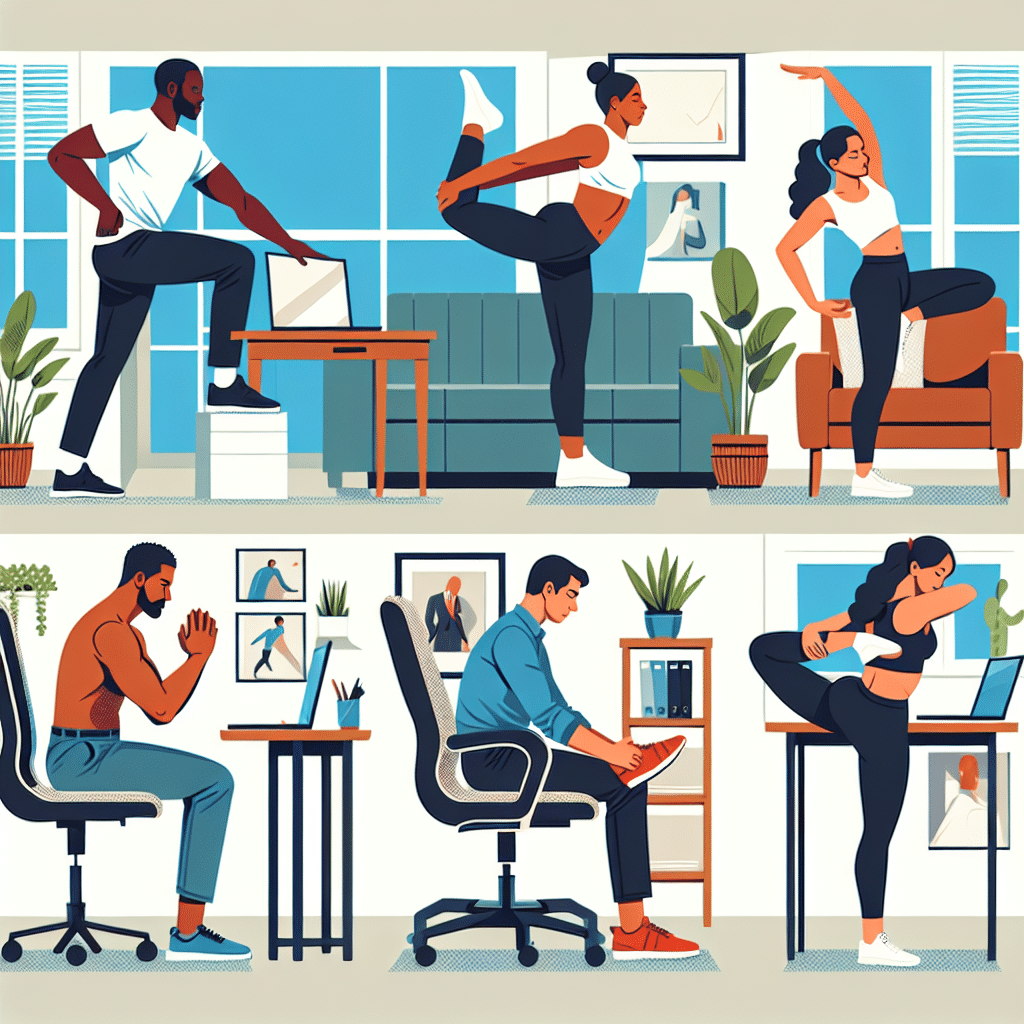The Importance of Stretching for Home Office Employees
With the rise of remote work, many employees find themselves spending prolonged periods seated at their desks. This can lead to various discomforts and health issues. Incorporating stretching routines into your day can significantly enhance your physical well-being, improve posture, and increase productivity.
Benefits of Stretching
-
Reduces Muscle Tension: Stretching can alleviate tension in muscles that may become tight from long hours of sitting. This helps to improve overall mobility and comfort.
-
Improves Circulation: Stretching increases blood flow to the muscles and can help reduce fatigue associated with stagnation.
-
Enhances Flexibility: Regular stretching promotes flexibility, which can improve your range of motion and help prevent injuries.
-
Posture Improvement: Sitting for extended periods can lead to poor posture. Stretching helps reinforce proper alignment and relieves stress on the spine.
-
Reduces Stress: Stretching has a calming effect on the body, providing an opportunity to take a mental break which can reduce overall stress levels.
Essential Stretching Routines
To effectively integrate stretching into your daily routine, consider setting specific intervals to perform these stretches. Aim for a short routine every hour or another schedule that works best for you.
1. Neck and Shoulder Stretches
-
Neck Tilts: Sit or stand up straight. Slowly tilt your head to one side until you feel a stretch on the opposite side of your neck. Hold for 15-30 seconds, then switch sides.
-
Shoulder Shrugs: Lift your shoulders towards your ears, hold for a moment, then relax them down. Repeat 10 times.
-
Shoulder Rolls: Roll your shoulders forward in a circular motion 10 times, then reverse and roll backward for another 10.
2. Upper Body Stretches
-
Chest Opener: Stand with your feet shoulder-width apart. Interlace your fingers behind your back and gently lift your arms to stretch the chest area. Hold for 15-30 seconds.
-
Upper Back Stretch: Extend both arms in front and round your upper back by bringing your shoulder blades apart. Hold for 15-30 seconds.
3. Lower Back and Spine Stretches
-
Seated Forward Bend: Sit on the edge of your chair and reach your hands toward your feet while keeping your knees slightly bent. Hold for up to 30 seconds.
-
Seated Spinal Twist: While seated, place one hand on the back of the chair and twist your torso gently to one side. Hold for 15-30 seconds, then switch sides.
4. Hip and Leg Stretches
-
Hip Flexor Stretch: Stand and take a step back with one leg. Gently lower your hips forward while keeping your back leg straight. Hold for 15-30 seconds then switch legs.
-
Hamstring Stretch: While seated, extend one leg forward and reach towards your toes while keeping your back straight. Hold for 15-30 seconds, then switch legs.
-
Quadriceps Stretch: Standing, pull one foot towards your glutes while keeping your knees together. Hold for 15-30 seconds and switch legs.
5. Wrist and Hand Stretches
-
Wrist Flexor Stretch: Extend one arm in front of you palm up, use your other hand to gently pull back on your fingers. Hold for 15-30 seconds and switch.
-
Finger Stretch: Open your hands wide and spread your fingers apart. Hold for 5 seconds, then make a fist and hold for another 5 seconds. Repeat several times.
Tips for Successful Stretching
-
Warm-Up: If possible, do a brief warm-up before stretching, such as marching in place for a minute or two.
-
Breathe Deeply: Incorporate deep breathing into your stretching routine. Inhale while preparing the stretch and exhale while holding it to enhance relaxation.
-
Listen to Your Body: Stretch only to the point of mild discomfort—not pain. If you experience pain, ease back.
-
Stay Consistent: Aim to incorporate stretching into your daily schedule. Consistency is key to experiencing the most benefits.
-
Environment: Create a comfortable, clutter-free space at your workspace. Consider using a yoga mat if you have space for floor stretches.
Integrating Stretching into Your Work Routine
To make stretching a habit, include it in your daily schedule. Here’s a sample stretching routine for home office employees:
- 9:00 AM: Neck and Shoulder Stretches (3 minutes)
- 11:00 AM: Upper Back and Chest Stretch (5 minutes)
- 1:00 PM: Lower Back and Spine Stretches (5 minutes)
- 3:00 PM: Hip and Leg Stretches (5 minutes)
- 5:00 PM: Wrist and Hand Stretches (3 minutes)
Setting reminders on your phone or computer can also help you stick to this schedule.
Conclusion: Shift the Culture
Advocating a culture that promotes stretching within your workplace—whether at home or in a traditional office—can be beneficial for overall employee wellness. Encourage team members to take stretch breaks together, share routines, and motivate one another to prioritize their health.
Incorporating these simple stretching routines can lead to improved health, enhanced productivity, and a better work-life balance for home office employees. Implementing this healthy practice will transform both physical and mental well-being over time.
